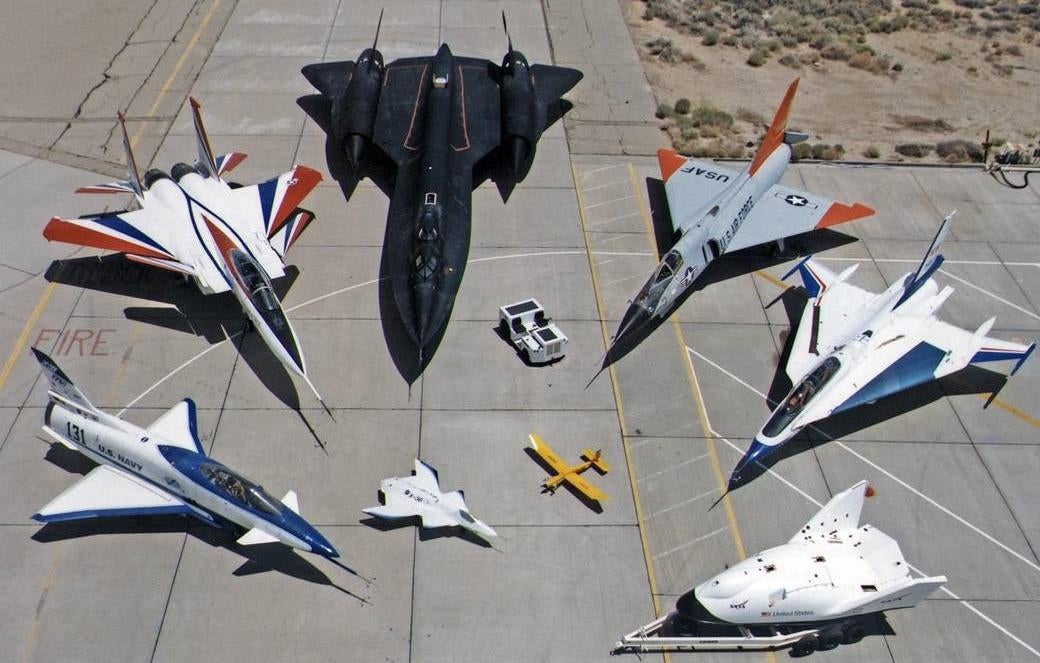03 October, 2022 | 01:00 AM
https://www.dailynews.express/posts/11-of-the-weirdest-x-plane-designs
11 of the Weirdest X-Plane Designs

X-planes are a class of experimental aircraft designed to test and demonstrate new innovations in flight — some were created for NASA, others for DARPA or the U.S. military. The first X-plane, X-1, was flown by Chuck Yeager in the 1940s and was the first craft to fly faster than the speed of sound. Over the decades, these aircraft have pushed the boundaries of what humans can do in the air. Here are some of the more bizarre products of our taxpayer dollars, ones that confound our typical understanding of what a plane looks like. Douglas X-3 Stiletto The Stiletto was the United States’ fledging aerospace agency’s (then NACA) first foray into aircraft designed for sustained supersonic flights. NACA thus designed the craft to be extremely aerodynamic, with a long, tapered nose and a narrow fuselage. The plane was named for the shoe, but it also looks a lot like a plague doctor’s mask. (Though you have to admit, the ‘X-3′ painted on its nose looks like a font well ahead of 1954.) NACA hoped the X-3 would be able to reach speeds of Mach 2, or twice the speed of sound, though it never achieved that goal. McDonnell Douglas X-36 This plane looks like it was inspired by a prostrate frog. The X-36 was an unmanned craft built to showcase a sort of tailless fighter jet that would be especially manoeuvrable in the air. Without the tail typical on such speedy aircraft, from above the X-36 looks more like a chevron than the classic lowercase t. The X-plane was built at quarter-scale, weighing in at 565 kg — about as much as a grizzly bear. Only two X-36s were ever built, and only one flew, according to the National Museum of the United States Air Force . X-57 Maxwell At first glance, this plane design looks almost normal. It’s got two wings — more than can be said for some of the other aircraft in this slideshow — and a cockpit for the pilot. Where the X-57 Maxwell splits is in how it’s powered. It is an entirely electric plane, with two lithium batteries tucked away in its cabin, a first for NASA and a hopeful portent of future energy shake-ups in flight. The Maxwell also has 14 propellers, which is probably at least 10 more than you normally think of a plane having. An aerospace engineer working on the electric plane told Gizmodo in 2021 that the X-57 could be “the tide that lifts all boats…or all planes.” With its first flight slated for spring 2022, we’ll hopefully be learning more soon. Bell X-5 The Bell X-5 is a pretty neat one — it looks mostly normal, perhaps even more than the X-57 Maxwell — but when it’s in the air, things change. The plane was the first aircraft that could change the sweep of its wings mid-flight. In other words, the Bell X-5 is a Transformer, one that changes from a plane that flies fast into one that flies very fast. Designed in the mid-1950s, the X-5 paved the way for future aircraft with wing-sweep designs, like the F-111 and the Grumman F-14 Tomcat. In that way, the Bell X-5 really did what any successful experimental plane ought to: showcase the utility of a new design or technology well enough that it becomes incorporated in future aircraft. Grumman X-29 This X-plane, 29th of its name, built on the swept-wing innovations of the X-5 but incorporated them into an aircraft 30 years more modern. First flown in 1984, the X-29 has forward-swept wings that seem counterintuitive. As it turns out, the forward sweep and the canards — the little wings in front of the plane’s main wings — reduce drag, speeding transit through the air. Unfortunately, it also made the X-29 inherently unstable — according to DARPA , “the most aerodynamically unstable aircraft ever built.” Whoops! The plane also brought along other breakthroughs, include a new digital flight-control system and carbon fibre wings, which allowed the relatively light plane to be more manoeuvrable. North American X-15 In a list filled with superlative and record-breaking aircraft, many would argue the X-15 beats them all. The plane is basically a rocket with a cockpit, as it could achieve beyond-hypersonic (Mach 5, more than five times the speed of sound) speeds and had to be dropped out of a plane before landing on its own. Conceived in the 1950s and flown in the 1960s, the X-15 was built to test the boundaries of flight; its record height in flight was set at just over 350,000 feet (108 km) above the ground. The X-15 advanced NASA’s (and just before that, NACA’s) understanding of how to build aircraft to deal with different pressures and temperatures as the plane moved at record-breaking speeds and glided down after its rocket stopped giving it thrust. The aircraft is evidence that a wacky design can be practical, too. X-24 The X-24 had no wings. Yet there it is, flying at dizzying heights above California. It was one of the last “lifting bodies” designed by NASA to demonstrate how pilots could cruise such wingless vehicles back to ground from space. The original X-24 was a bulbous teardrop shape, but the X-24B (photographed above) switched to a compressed flatiron shape. The design was aerodynamically sound, and the aircraft would glide unpowered to ground at speeds of over 1,609 km per hour. If you just said “gnarly” out loud, you’d be right. X-43 The Hyper-X was so called because it flew at over five times the speed of sound. The 43rd X-plane in the government’s catalogues, the aircraft was the first to demonstrate scramjet propulsion, in which airflow through the vehicle’s engine remains at supersonic speeds. This allows the craft to keep moving at extremely fast speeds, as the X-43 exhibited twice ; once in March 2004 when it flew at Mach 6.83, outpacing the record set by the rocket plane X-15, and again in November 2004 when it flew at an astonishing Mach 9.6 — almost 11,265 km per hour. Now, the X-43’s engine ran for only about 10 seconds, so sustaining flight at such speeds is another matter. X-33 The X-33 is an odd one, in that it was designed in the late 2000s for an idea that we’ve only begun to see the next stage of over the last few years. Lockheed Martin designed the wedge-shaped X-33 to be a reusable launch vehicle, one with commercial implications. (Sound familiar to any ideas you’ve heard floating around of late?) Though it never got far out of the conceptual stage (NASA did go as far as testing its thermal protection materials in 1998), the plan was for the X-33 to be an uncrewed spaceplane that launched vertically and landed back on Earth horizontally. The program was cancelled in the early 2000s after engineers couldn’t resolve technical problems with the aircraft’s liquid hydrogen fuel tank. X-48 The X-48 was made in the late 2000s to test a new shape of plane that could be quieter and more environmentally friendly than existing designs. Over the course of its six years of testing , it was deemed a resounding success by those involved with the project. Shaped like a chevron (or a manta ray, for the more aquatically inclined) X-48 showed off design called ‘hybrid wing body,’ in which the wings and the body of the plane are sort of one and the same. In their testing, NASA found that the plane was able to fly with greater fuel efficiency and less noise than existing aircraft. While that doesn’t mean we’ll all be flying around in big metal manta rays, it could mean that future aeroplanes may have a slightly different shape than they have today. Lockheed Martin X-59 QueSST From its initial cut of metal in 2018 to now, the production of the X-59 is still very much underway, but it lines up with the X-57 as one of the most exciting X-planes currently in development. The X-59 is basically what the X-3 Stiletto and the X-15 rocket plane were building toward: a supersonic plane that can fly without a sonic boom. Its nose alone is 9.14 m long, and the sky in front of the cockpit is visualised on a 4K computer monitor that pulls visuals from cameras mounted on either side of the nose. (If the pilots were to look nakedly down the plane’s nose, they wouldn’t be able to see the sky in front of them.) Ground tests were set to begin in Texas in early 2022 , and NASA plans to fly the aircraft over communities in 2024 to see if the sonic booms can be heard on the ground. Even if supersonic flight doesn’t take off again — RIP Concorde — this thing is wicked cool. This article has been updated since it was first published.





